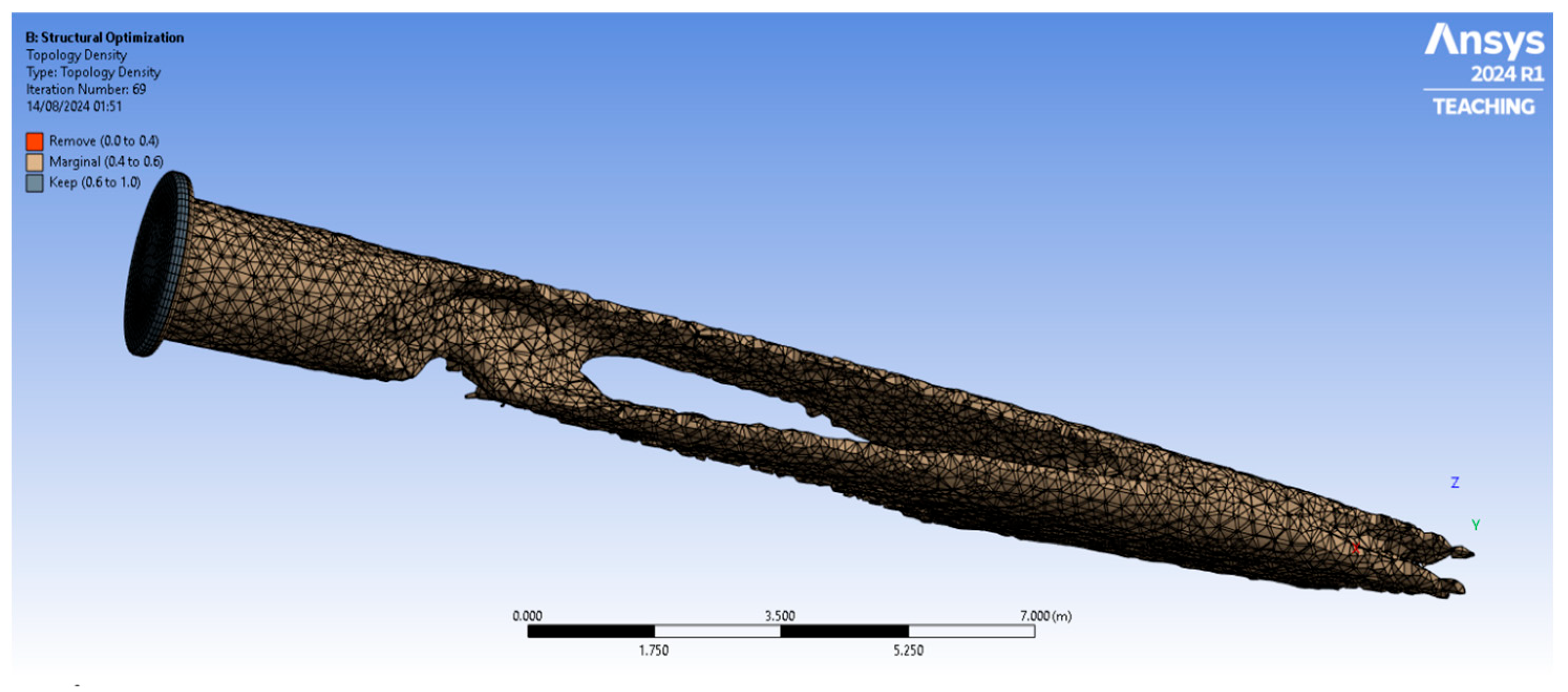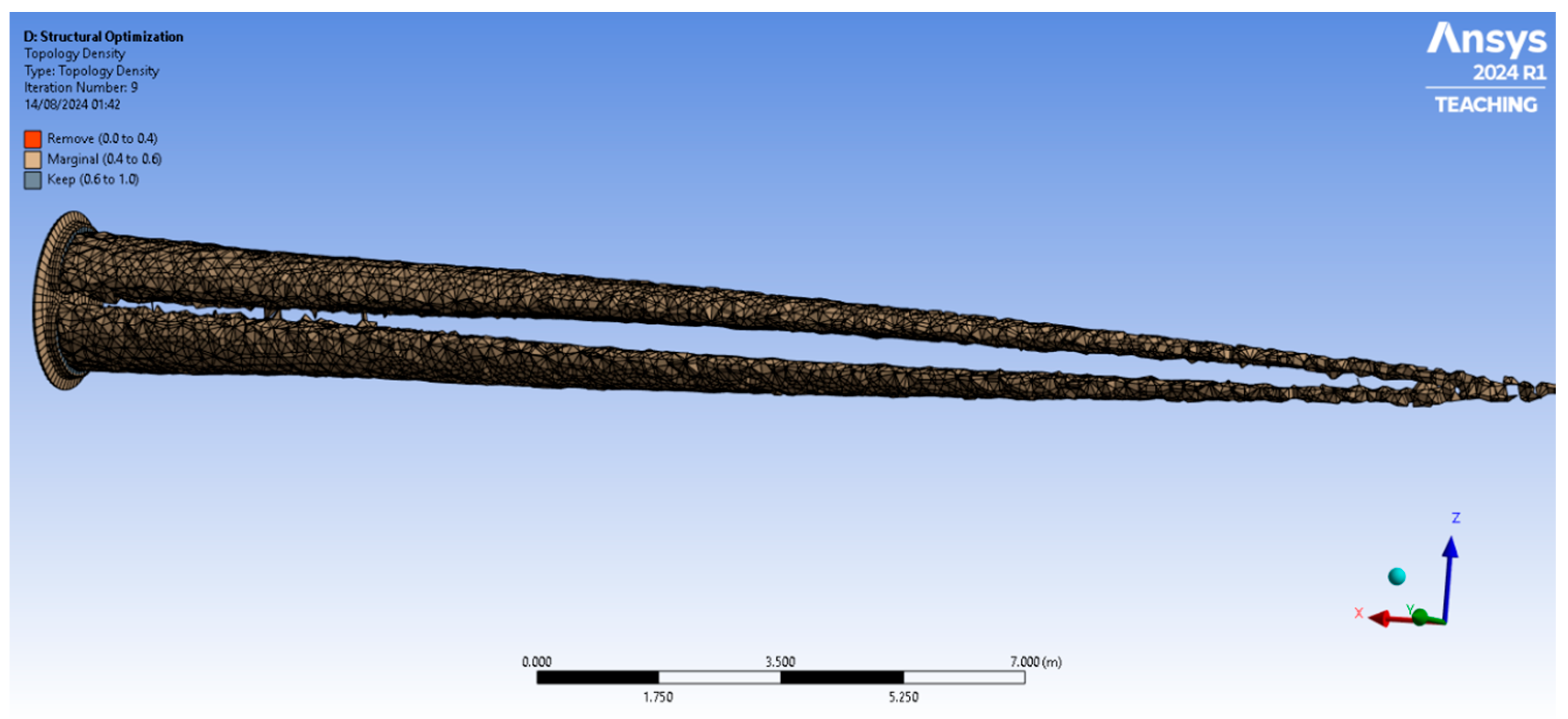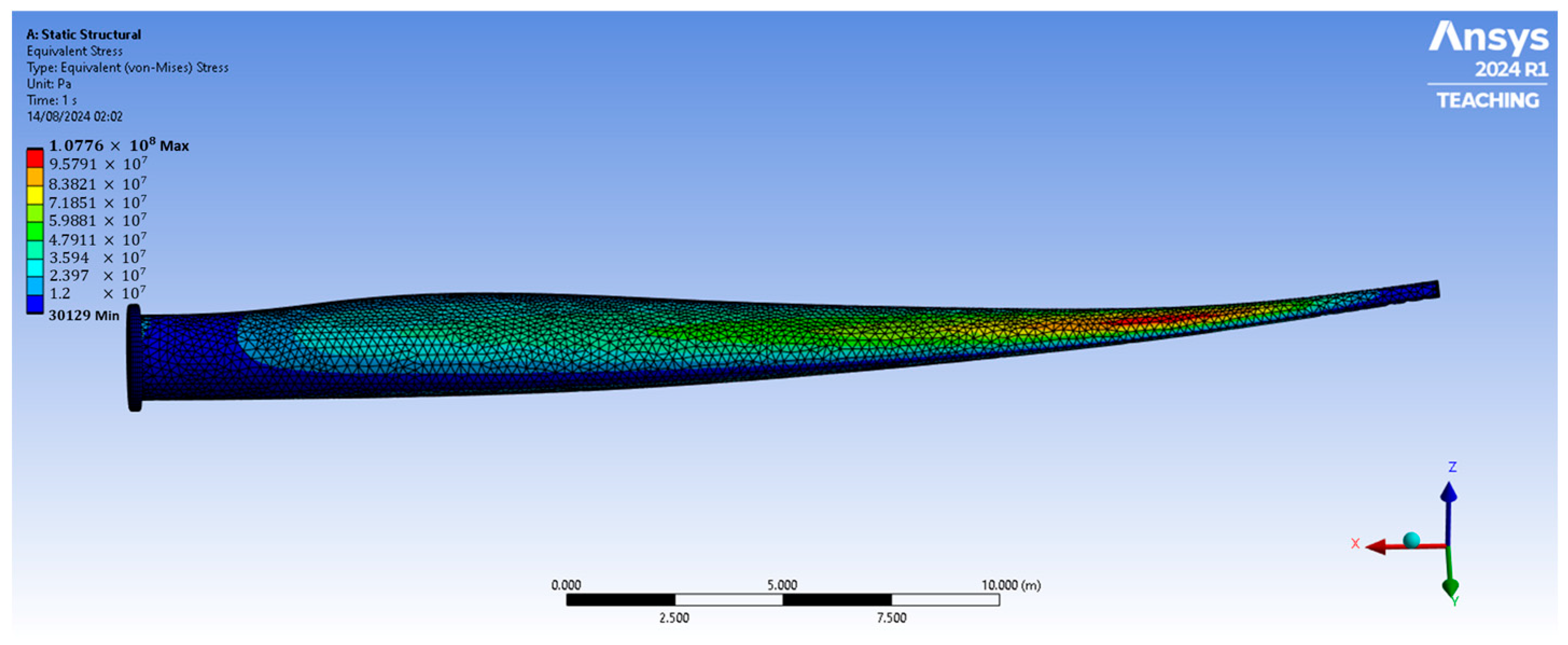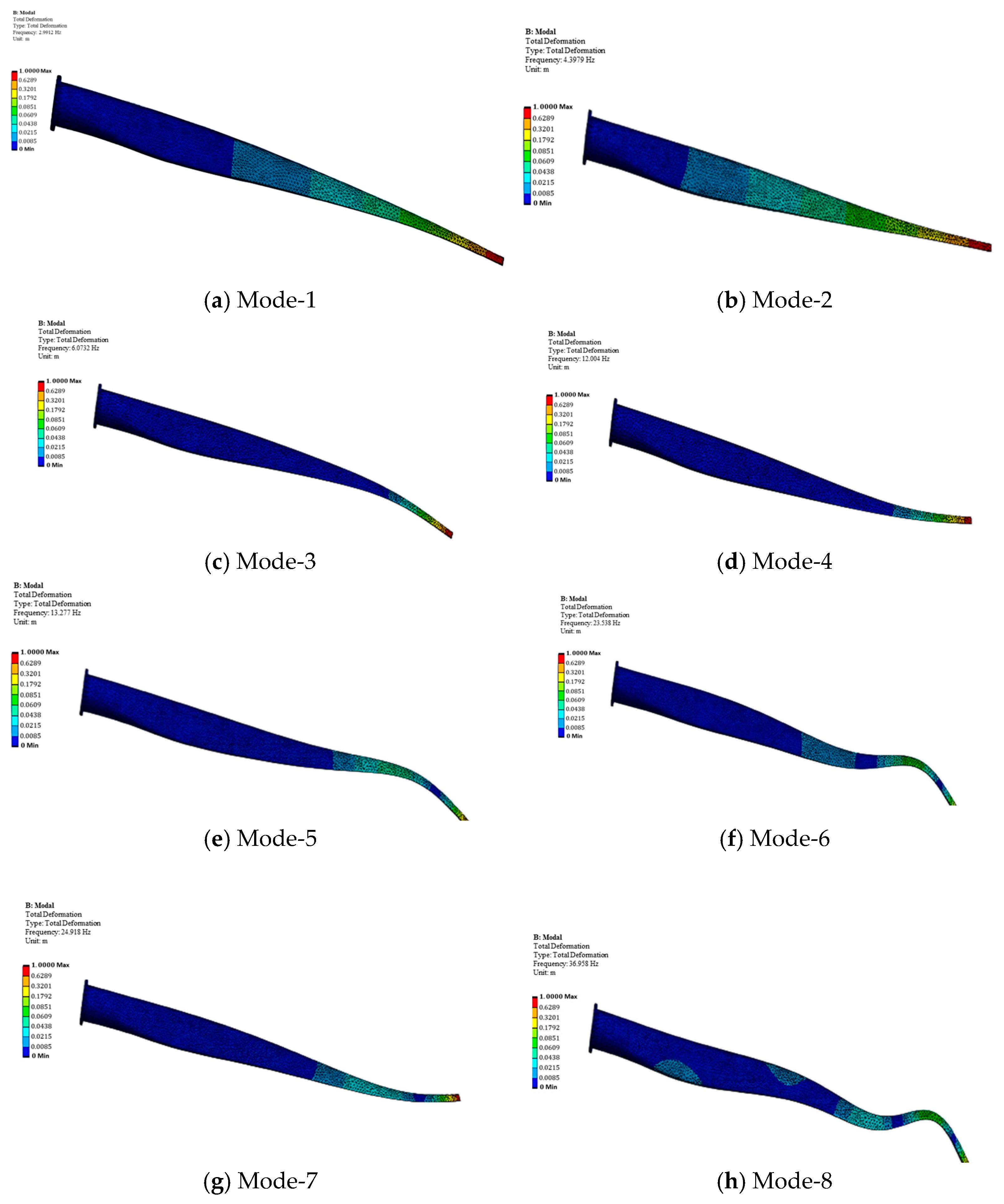Structural Topology Optimisation of a Composite Wind Turbine Blade Under Various Constraints
Abstract
1. Introduction
2. Description of the Wind Turbine Blade
2.1. Geometry of the Blade
2.2. Mechanical Properties of the Materials
2.3. Exploring the Mechanical Characteristics of the Blade
3. Topology Optimisation of the Wind Turbine Blades
3.1. Initial Design and Constraints
3.1.1. Blade Geometry, Mesh Structure and the Numerical Model
3.1.2. Boundary Conditions and Load Cases
3.2. Optimisation Process with Static and Modal Constraints
3.2.1. Objective Function and Constraint Formulation
3.2.2. Convergence Criteria
4. Results and Discussion
4.1. Mesh Convergence Study
4.2. Analysis of the Initial Geometry
4.3. Topology Optimisation Studies
4.4. Full Scale Analysis of the Optimised Model Based on the Static Optimisation Criteria
4.4.1. Rationale for Choosing the Static-Optimised Blade
4.4.2. Stress Distribution of the Static-Optimised Blade
4.4.3. Modal Analysis of the Static-Optimised Blade
- Mode 1 (2.9912 Hz)—Primarily a flapwise bending mode, indicative of the blade’s large aspect ratio and overall flexibility in the direction of aerodynamic loading.
- Mode 2 (4.3979 Hz)—The first edgewise bending mode, representing in-plane flexibility due to gravitational and inertial effects.
- Modes 3, 4, 5, 6, 7 (6.0732 Hz, 12.004 Hz, 13.277 Hz, 23.538 Hz, and 24.918 Hz)—Higher-order bending modes involving multiple nodal points, reflecting the dynamic response under more complex excitation patterns.
- Modes 8, 9, 10 (36.958 Hz, 42.521 Hz, and 43.781 Hz)—Torsional modes, characterising twist deformation about the longitudinal axis, which is particularly relevant for aerodynamic stability and fatigue.
4.5. Final Remarks and Discussions
5. Conclusions
Author Contributions
Funding
Data Availability Statement
Acknowledgments
Conflicts of Interest
References
- Buckney, N.; Pirrera, A.; Green, S.D.; Weaver, P.M. Structural Efficiency of a Wind Turbine Blade. Thin-Walled Struct. 2013, 67, 144–154. [Google Scholar] [CrossRef]
- Zhu, J.; Cai, X.; Ma, D.; Zhang, J.; Ni, X. Improved Structural Design of Wind Turbine Blade Based on Topology and Size Optimization. Int. J. Low-Carbon Technol. 2022, 17, 69–79. [Google Scholar] [CrossRef]
- Wang, Z.; Suiker, A.S.J.; Hofmeyer, H.; van Hooff, T.; Blocken, B. Coupled Aerostructural Shape and Topology Optimization of Horizontal-Axis Wind Turbine Rotor Blades. Energy Convers. Manag. 2020, 212, 112621. [Google Scholar] [CrossRef]
- Greeshma, V.S.; Rajakumar, S. Sravanthi Fatigue Analysis of Wind Turbine Blade for Various Materials. Mater. Today Proc. 2023. [Google Scholar] [CrossRef]
- Jayswal, S.; Bhattu, A. Structural and Modal Analysis of Small Wind Turbine Blade Using Three Different Materials. Mater. Today Proc. 2023, 72, 1347–1352. [Google Scholar] [CrossRef]
- Appadurai, M.; Raj, E.F.I. Finite Element Analysis of Composite Wind Turbine Blades. In Proceedings of the 7th International Conference on Electrical Energy Systems, ICEES 2021; IEEE: New York, NY, USA, 2021; pp. 585–589. [Google Scholar] [CrossRef]
- Gukendran, R.; Sambathkumar, M.; Sabari, C.; Raj, C.R.R.; Kumar, V.R. Structural Analysis of Composite Wind Turbine Blade Using ANSYS. Mater. Today Proc. 2021, 50, 1011–1016. [Google Scholar] [CrossRef]
- Krishnan, A.; Al-Obaidi, A.S.M.; Hao, L.C. A Comprehensive Review of Innovative Wind Turbine Airfoil and Blade Designs: Toward Enhanced Efficiency and Sustainability. Sustain. Energy Technol. Assess. 2023, 60, 103511. [Google Scholar] [CrossRef]
- Yirtici, O.; Tuncer, I.H. Aerodynamic Shape Optimization of Wind Turbine Blades for Minimizing Power Production Losses Due to Icing. Cold Reg. Sci. Technol. 2021, 185, 103250. [Google Scholar] [CrossRef]
- Shen, X.; Yang, H.; Chen, J.; Zhu, X.; Du, Z. Aerodynamic Shape Optimization of Non-Straight Small Wind Turbine Blades. Energy Convers. Manag. 2016, 119, 266–278. [Google Scholar] [CrossRef]
- Tüfekci, M.; Genel, Ö.E.; Tatar, A.; Tüfekci, E. Dynamic Analysis of Composite Wind Turbine Blades as Beams: An Analytical and Numerical Study. Vibration 2020, 4, 1–15. [Google Scholar] [CrossRef]
- Blasques, J.P.; Bitsche, R.D.; Fedorov, V.; Lazarov, B.S. Accuracy of an Efficient Framework for Structural Analysis of Wind Turbine Blades. Wind. Energy 2016, 19, 1603–1621. [Google Scholar] [CrossRef]
- Branner, K.; Blasques, J.P.; Kim, T.; Fedorov, V.A.; Berring, P.; Bitsche, R.D.; Berggreen, C.; Branner, K.; Blasques, J.P.; Kim, T.; et al. Anisotropic Beam Model for Analysis and Design of Passive Controlled Wind Turbine Blades; DTU Wind Energy: Roskilde, Denmark, 2012; Volume 0001. [Google Scholar]
- Tufekci, M.; Rendu, Q.; Yuan, J.; Dear, J.P.; Salles, L.; Cherednichenko, A.V. Stress and Modal Analysis of a Rotating Blade and the Effects of Nonlocality. In Proceedings of the ASME Turbo Expo; American Society of Mechanical Engineers: New York, NY, USA, 2020; Volume 10B-2020, pp. 1–12. [Google Scholar]
- Koç, H.; Genel, Ö.E.; Tüfekci, M.; Tüfekci, E. Analysis of the Dynamical Behaviour of Spinning Annular Disks with Various Boundary Conditions. Mech. Based Des. Struct. Mach. 2023, 51, 5427–5451. [Google Scholar] [CrossRef]
- Ullah, H.; Ullah, B.; Silberschmidt, V.V. Structural Integrity Analysis and Damage Assessment of a Long Composite Wind Turbine Blade under Extreme Loading. Compos. Struct. 2020, 246, 112426. [Google Scholar] [CrossRef]
- Devi, S.; Nagaraja, K.V. Enhanced Aerodynamic Performance of Wind Turbine Blades by Finite Element Meshing in Energy Applications. In Proceedings of the 2021 IEEE International Conference on Emerging Trends in Industry 4.0, ETI 4.0 2021, Raigarh, India, 19–21 May 2021; pp. 1–5. [Google Scholar] [CrossRef]
- Jeong, M.S.; Lee, I.; Yoo, S.J.; Park, K.C. Torsional Stiffness Effects on the Dynamic Stability of a Horizontal Axis Wind Turbine Blade. Energies 2013, 6, 2242–2261. [Google Scholar] [CrossRef]
- Roul, R.; Kumar, A. Fluid-Structure Interaction of Wind Turbine Blade Using Four Different Materials: Numerical Investigation. Symmetry 2020, 12, 1467. [Google Scholar] [CrossRef]
- Elsherif, D.M.; Abd El-Wahab, A.A.; Abdellatif, M.H. Factors Affecting Stress Distribution in Wind Turbine Blade. In Proceedings of the IOP Conference Series: Materials Science and Engineering; IOP Publishing: Philadelphia, PA, USA, 2019; Volume 610. [Google Scholar]
- Bechly, M.E.; Clausen, P.D. Structural Design of a Composite Wind Turbine Blade Using Finite Element Analysis. Comput. Struct. 1997, 63, 639–646. [Google Scholar] [CrossRef]
- Chiu, P.K.; Roth-Johnson, P.; Wirz, R.E. Optimal Structural Design of Biplane Wind Turbine Blades. Renew. Energy 2020, 147, 2440–2452. [Google Scholar] [CrossRef]
- Pal, A.; Bertoldi, K.; Pham, M.Q.; Schaenzer, M.; Gross, A.J. Optimal Turbine Blade Design Enabled by Auxetic Honeycomb. Smart Mater. Struct. 2020, 29, 125004. [Google Scholar] [CrossRef]
- Wood, R.J.K.; Lu, P. Leading Edge Topography of Blades-a Critical Review. Surf. Topogr. 2021, 9, 023001. [Google Scholar] [CrossRef]
- Mikkelsen, L.P. A Simplified Model Predicting the Weight of the Load Carrying Beam in a Wind Turbine Blade. IOP Conf. Ser. Mater. Sci. Eng. 2016, 139, 012038. [Google Scholar] [CrossRef]
- Baumgart, A. A Mathematical Model for Wind Turbine Blades. J. Sound. Vib. 2002, 251, 1–12. [Google Scholar] [CrossRef]
- Genel, Ö.E.; Tüfekci, E. Bending-Bending Coupled Static Analysis of Functionally Graded and Porous Pretwisted Cantilever Beams Using Initial Values Method. Mech. Based Des. Struct. Mach. 2023, 52, 2480–2503. [Google Scholar] [CrossRef]
- Genel, Ö.E.; Tüfekci, E. Axial–Torsional Coupled Static Behavior of Inhomogeneous Pretwisted Cantilever Beams. Acta Mech. 2023, 234, 3421–3436. [Google Scholar] [CrossRef]
- Fagan, E.M.; De La Torre, O.; Leen, S.B.; Goggins, J. Validation of the Multi-Objective Structural Optimisation of a Composite Wind Turbine Blade. Compos. Struct. 2018, 204, 567–577. [Google Scholar] [CrossRef]
- Jureczko, M.; Pawlak, M.; Mȩzyk, A. Optimisation of Wind Turbine Blades. J. Mater. Process Technol. 2005, 167, 463–471. [Google Scholar] [CrossRef]
- Vincekovic, L.; John, A.; Qin, N.; Shahpar, S. Exploring Topology Optimization for High Pressure Turbine Blade Tips. J. Turbomach. 2022, 144, 071013. [Google Scholar] [CrossRef]
- Song, J.; Chen, J.; Wu, Y.; Li, L. Topology Optimization-Driven Design for Offshore Composite Wind Turbine Blades. J. Mar. Sci. Eng. 2022, 10, 1487. [Google Scholar] [CrossRef]
- Han, P. Additive Design and Manufacturing of Jet Engine Parts. Engineering 2017, 3, 648–652. [Google Scholar] [CrossRef]
- Meng, J.; Liao, L.F.; Li, D.; Cao, Y.; Yang, L.Y.; Chen, Y.Y. Topology Optimization Method Research on Hollow Wide-Chord Fan Blade of a High-Bypass Turbofan Engine. Procedia Eng. 2015, 99, 1228–1233. [Google Scholar] [CrossRef]
- Barreau, V.; Denimal, E.; Salles, L. Topological Optimisation and 3D Printing of a Bladed Disc. In Proceedings of the ASME Turbo Expo; American Society of Mechanical Engineers: New York, NY, USA, 2022; Volume 8. [Google Scholar]
- Wei, J.; Zhang, Y.; Liu, Y.; Wang, Y.; Li, C.; Sun, Z.; Xu, H.; Shao, H.; Zhang, D.; Zou, Q.; et al. Advances in Resin Matrix Composite Fan Blades for Aircraft Engines: A Review. Thin-Walled Struct. 2024, 202, 112058. [Google Scholar] [CrossRef]
- Ahmad, F.; Kumar, P.; Patil, P.P.; Dobriyal, R.; Avikal, S. Comparative Analysis of Two and Four Blades Quadcopter Propellers Based on Finite Element Method. Mater. Today Proc. 2023. [Google Scholar] [CrossRef]
- Zhang, D.; Liu, Z.; Li, W.; Zhang, J.; Cheng, L.; Hu, G. Fluid-Structure Interaction Analysis of Wind Turbine Aerodynamic Loads and Aeroelastic Responses Considering Blade and Tower Flexibility. Eng. Struct. 2024, 301, 117289. [Google Scholar] [CrossRef]
- Luczak, M.; Manzato, S.; Peeters, B.; Branner, K.; Berring, P.; Kahsin, M. Updating Finite Element Model of a Wind Turbine Blade Section Using Experimental Modal Analysis Results. Shock. Vib. 2014, 2014, 684786. [Google Scholar] [CrossRef]
- Iddou, H.; Bouda, N.N.; Zereg, K. Computational Fluid Dynamics Study on the Efficiency of Straight-Bladed Vertical Axis Wind Turbine. Int. J. Thermofluids 2024, 22, 100672. [Google Scholar] [CrossRef]
- Ghafoorian, F.; Enayati, E.; Mirmotahari, S.R.; Wan, H. Self-Starting Improvement and Performance Enhancement in Darrieus VAWTs Using Auxiliary Blades and Deflectors. Machines 2024, 12, 806. [Google Scholar] [CrossRef]
- Ghafoorian, F.; Hosseini Rad, S.; Moghimi, M. Enhancing Self-Starting Capability and Efficiency of Hybrid Darrieus–Savonius Vertical Axis Wind Turbines with a Dual-Shaft Configuration. Machines 2025, 13, 87. [Google Scholar] [CrossRef]
- Farajyar, S.; Ghafoorian, F.; Mehrpooya, M.; Asadbeigi, M. CFD Investigation and Optimization on the Aerodynamic Performance of a Savonius Vertical Axis Wind Turbine and Its Installation in a Hybrid Power Supply System: A Case Study in Iran. Sustainability 2023, 15, 5318. [Google Scholar] [CrossRef]
- Chamran, S.; Ghafoorian, F.; Wan, H.; Chegini, S. A Systematic Analysis of a Small-Scale HAWT Configuration and Aerodynamic Performance Optimization Through Kriging, Factorial, and RSM Methods. J. Appl. Comput. Mech. 2025, 11, 887–903. [Google Scholar] [CrossRef]
- Tüfekci, M.; Öztekin, V.; Pir, İ.; Alioğlu, M.; Dikicioğlu, C.; Dikicioğlu, A.; Tüfekci, E. Low Strain Rate Mechanical Performance of Balsa Wood and Carbon Fibre-Epoxy-Balsa Sandwich Structures. Compos. Part. C Open Access 2023, 12, 100416. [Google Scholar] [CrossRef]
- Tüfekci, M.; Koçak, O.; Özkan, Y.; Pir, İ.; Tüfekci, E. Numerical Evaluation of Design Strategies for a Composite Wind Turbine Blade: Using Metallic Foams and Optimising Topology. Energy Sci. Eng. 2025, 13, 1457–1477. [Google Scholar] [CrossRef]
- Vieira, F.; Tüfekci, M.; Patel, S.; Pimenta, S. A Comprehensive Numerical Modelling of a Benchmark Wind Turbine Blade. In Proceedings of the ASME 2025 Aerospace Structures, Structural Dynamics, and Materials Conference; American Society of Mechanical Engineers: New York, NY, USA, 2025. [Google Scholar]







| Parameter | Value |
|---|---|
| Blade Length | 30.27 m |
| Root Diameter | 2.47 m |
| Original Mass | 4.553 × 105 kg |
| Property | Value | Units |
|---|---|---|
| Ply thickness | 0.327 | mm |
| Density | 1.76 | g/cm3 |
| Fibre volume fraction | ~60 | % |
| Longitudinal modulus, E1 | 141 | GPa |
| Transverse modulus, E2 | 8.7 | GPa |
| Shear modulus, G12, G13 | 5.6 | GPa |
| Shear modulus, G23 | 3.7 | GPa |
| Poisson’s ratio, ν12, ν13 | 0.3 | – |
| Poisson’s ratio, ν23 | 0.4 | – |
| Mesh Level | Max. Element Size (m) | No. of Elements | Max. Displacement (m) | Relative Error Disp. (%) | Fundamental Frequency (Hz) | Relative Error Freq. (%) |
|---|---|---|---|---|---|---|
| 1 | 0.5 | 15,200 | 5.4 × 10−7 | 8.5 | 3.17 | 6 |
| 2 | 0.35 | 31,600 | 5.65 × 10−7 | 4.2 | 3.08 | 3 |
| 3 | 0.25 | 47,900 | 5.8 × 10−7 | 1.7 | 3.01 | 0.7 |
| 4 (Final) | 0.2 | 64,410 | 5.9 × 10−7 | 0 | 2.99 | 0 |
| Analysis Characteristics | 1st Test | 2nd Test | 3rd Test |
|---|---|---|---|
| Aero-pressure magnitude | 10,000 Pa | 20,000 Pa | 30,000 Pa |
| Total Deformation (Maximum) | 5.9004 × 10−7 | 1.1801 × 10−7 | 1.7701 × 10−6 |
| Von Mises stress (Maximum) | 12,242 | 24,483 | 36,725 |
| Maximum principle Elastic strain (Maximum) | 3.9426 × 10−8 m | 7.8851 × 10−8 m | 1.1828 × 10−7 m |
| Flapwise Direction Deformation (Maximum) | 4.0642 × 10−7 m | 8.1284 × 10−7 | 1.2193 × 10−7 m |
| Fundamental Natural Frequency | 2.3217 Hz | 2.3342 Hz | 2.3508 Hz |
| Static Topology Parameters | Results | Modal Topology Parameters | Results |
|---|---|---|---|
| Original volume | 58 m3 | Original volume | 58 m3 |
| Final volume | 29.757 m3 | Final volume | 29.47 m3 |
| Reduced mass/volume percentage compared to the original mass/volume | 51.306 | Reduced mass/volume percentage compared to the original mass/volume | 50.81 |
| Original mass | 4.553 × 105 kg | Original mass | 4.553 × 105 kg |
| Final mass | 2.3359 × 105 kg | Final mass | 2.313 × 105 kg |
| Mode Number | Frequency (Hz) | Description |
|---|---|---|
| Mode 1 | 2.9912 | 1st flapwise bending mode |
| Mode 2 | 4.3979 | 1st edgewise bending mode |
| Mode 3 | 6.0732 | 2nd flapwise bending mode |
| Mode 4 | 12.004 | 2nd edgewise bending mode |
| Mode 5 | 13.277 | 3rd flapwise bending mode |
| Mode 6 | 23.538 | 3rd edgewise bending mode |
| Mode 7 | 24.918 | 4th flapwise bending mode |
| Mode 8 | 36.958 | 1st torsional mode |
| Mode 9 | 42.521 | 2nd torsional mode |
| Mode 10 | 43.781 | 3rd torsional mode |
Disclaimer/Publisher’s Note: The statements, opinions and data contained in all publications are solely those of the individual author(s) and contributor(s) and not of MDPI and/or the editor(s). MDPI and/or the editor(s) disclaim responsibility for any injury to people or property resulting from any ideas, methods, instructions or products referred to in the content. |
© 2025 by the authors. Licensee MDPI, Basel, Switzerland. This article is an open access article distributed under the terms and conditions of the Creative Commons Attribution (CC BY) license (https://creativecommons.org/licenses/by/4.0/).
Share and Cite
Khan, M.N.A.; Tüfekci, M. Structural Topology Optimisation of a Composite Wind Turbine Blade Under Various Constraints. Wind 2025, 5, 23. https://doi.org/10.3390/wind5040023
Khan MNA, Tüfekci M. Structural Topology Optimisation of a Composite Wind Turbine Blade Under Various Constraints. Wind. 2025; 5(4):23. https://doi.org/10.3390/wind5040023
Chicago/Turabian StyleKhan, Mohamed Noufel Ajmal, and Mertol Tüfekci. 2025. "Structural Topology Optimisation of a Composite Wind Turbine Blade Under Various Constraints" Wind 5, no. 4: 23. https://doi.org/10.3390/wind5040023
APA StyleKhan, M. N. A., & Tüfekci, M. (2025). Structural Topology Optimisation of a Composite Wind Turbine Blade Under Various Constraints. Wind, 5(4), 23. https://doi.org/10.3390/wind5040023








